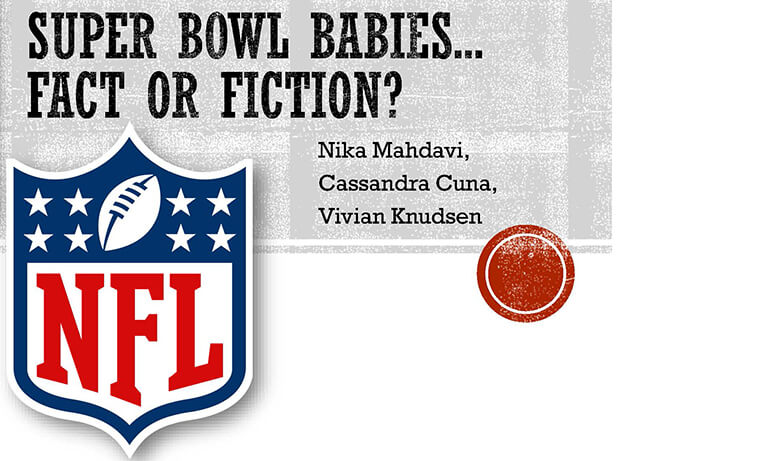Students analyze claim that winning cities see rise in birth 9 months after victory
Vivian Knudsen knew just the question she wanted to answer for a class project on data analysis: Is the phenomenon of Super Bowl babies real?
In 2016, Knudsen watched a captivating commercial for Super Bowl 50 between the Denver Broncos and Carolina Panthers that presented a claim about a reported surge of babies born nine months after their parents’ team won the big game.
She’d wondered about the assertion over the years, but an industrial engineering class finally gave her the tools to check its accuracy.
Knudsen and her classmates learned how to use big data in decision-making during Professor Puneet Agarwal’s class in spring 2022. For the final project, students had to find data sets they could analyze, then present their findings to their professor and peers.
Knudsen remembered the commercial she had watched six years ago and knew it would fit the criteria while answering her lingering question whether winning cities see a rise in births nine months after the Super Bowl.
The NFL opens its high-profile commercial with the claim that data supports such a rise, personified by a choir of “babies” from 49-year-olds to 1-year-olds, all sporting the apparel of the team responsible for their conception.
The Super Bowl Babies Choir sings a parody of Seal’s “Kiss from a Rose,” with Seal himself singing along. “What makes the Super Bowl so super?” the first group of kids croon. “A day we adore. It is a day, so super, it’s why we were born.”
The 60-second commercial that now lives on YouTube also features snippets of post-victory reactions to show the excitement that may have led to a baby boom.
Initially, Knudsen saw some validity in the NFL’s claim.
“I’m not sure how passionate people are about football, but why couldn’t it be an overall phenomenon?” she asked.
Nika Mahdavi and Cassandra Cuna were more skeptical but agreed with Knudsen that the premise should be tested. Ironically, the three industrial engineering seniors are not football fans.
“I couldn’t even tell you the rules of the game,” Knudsen joked.

The trio began by gathering data on the winning teams from 2008 to 2020, including how many babies were born in the counties of the victors nine months after the Super Bowl.
Their biggest challenge, Knudsen said, was weeding out counties that shared the same name. For example, they needed data from King County in Washington but not King County in Kansas.
“You can’t believe how many Washington counties there are,” Knudsen added.
After filtering, combining, sorting, graphing and mapping the data, Knudsen’s group concluded that the Super Bowl baby phenomenon is indeed a myth.
“The percent differences per county on a Super Bowl year were so scattered, there’s no way it could be true,” Knudsen said. “Just because there might be 10 Super Bowl babies born in a county doesn’t mean the entire county is fueling a population boom.”
As a result of the project, Knudsen is filtering information through a more critical lens.
“Don’t believe everything you hear,” Knudsen cautioned her fellow media consumers. “If it sounds too good to be true, it probably is.”
Now, Knudsen said she has the know-how to fact-check any claim.
“It’s a cool skill I’ve developed,” Knudsen said.
That skill came into direct play during three different internship interviews where she fielded the same question, “When did you analyze a large amount of data to make a decision?”
Knudsen described her industrial engineering class project, which she said always leaves an impression.
“They remember me as ‘Super Bowl Baby girl,’” she said, laughing, “but it must work because I’m three for three on internship offers.”
By Emily Slater


